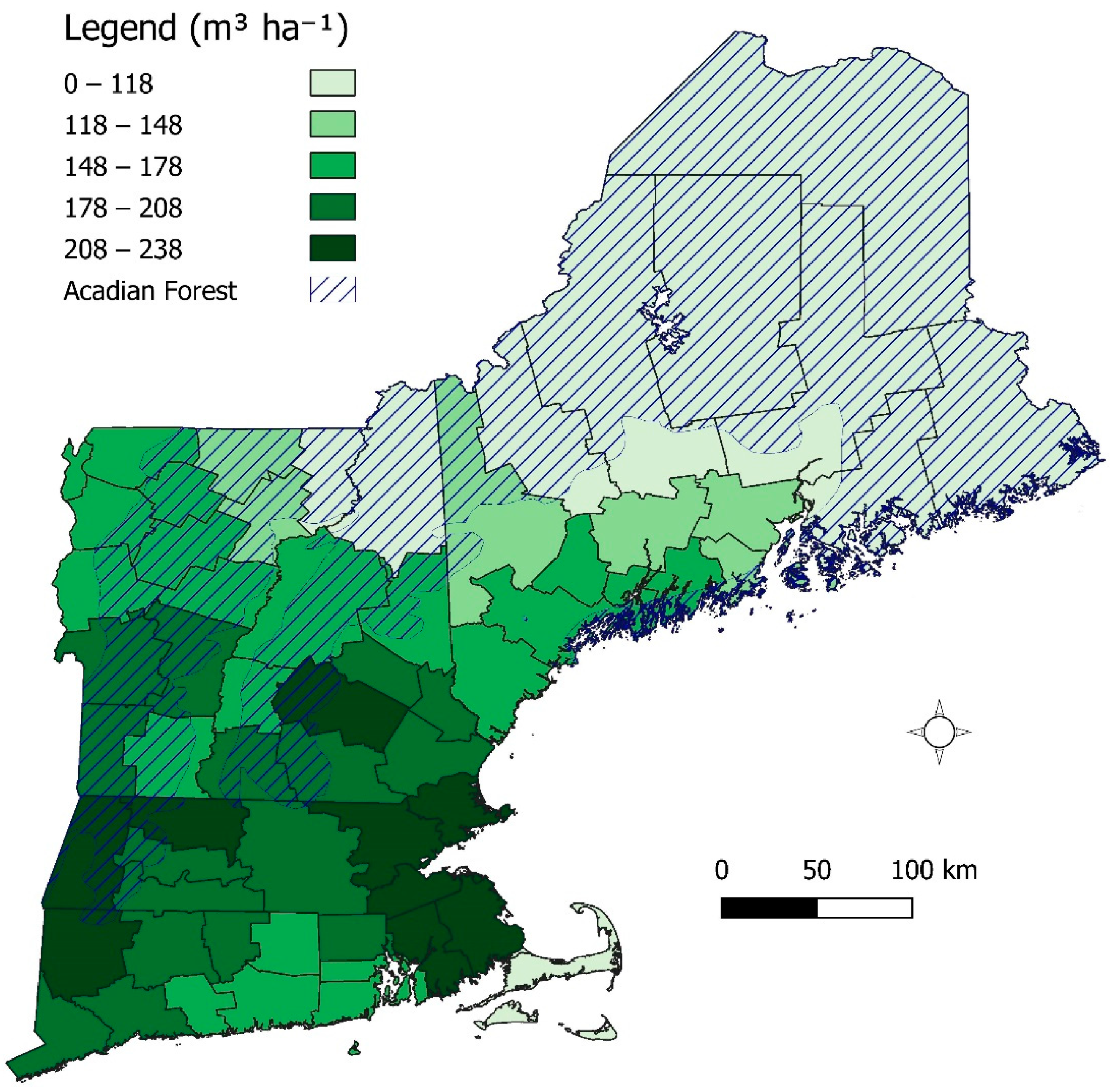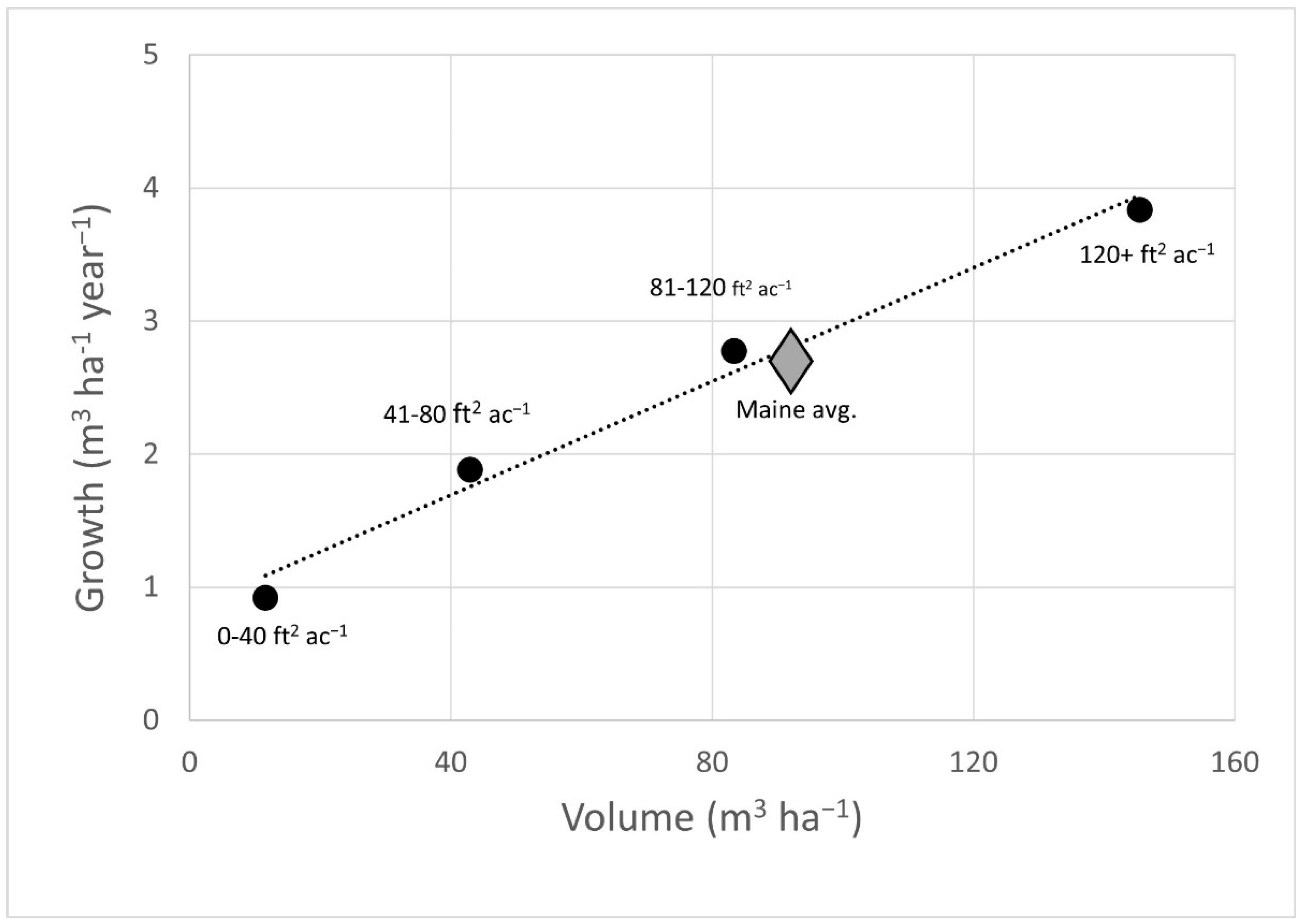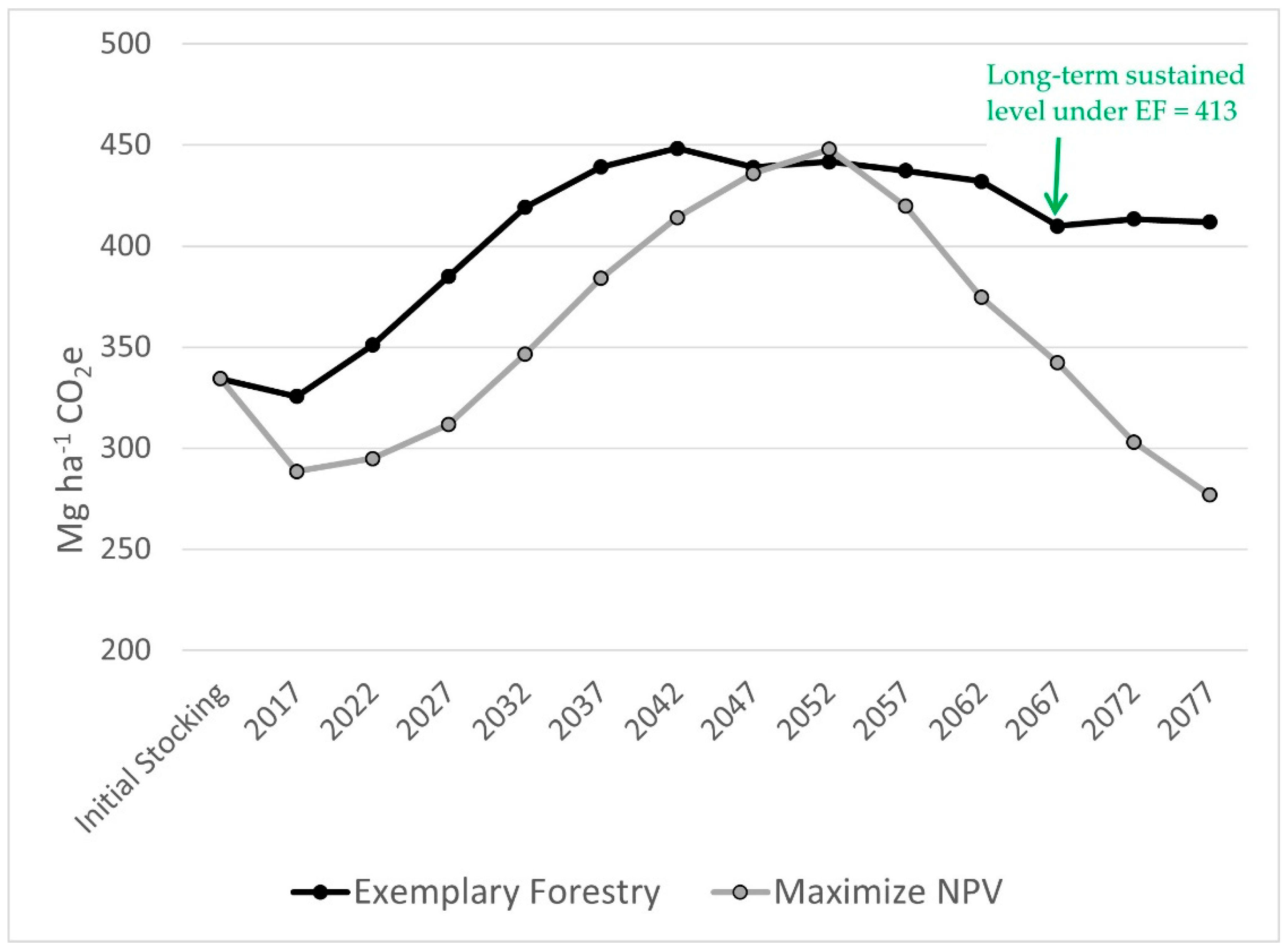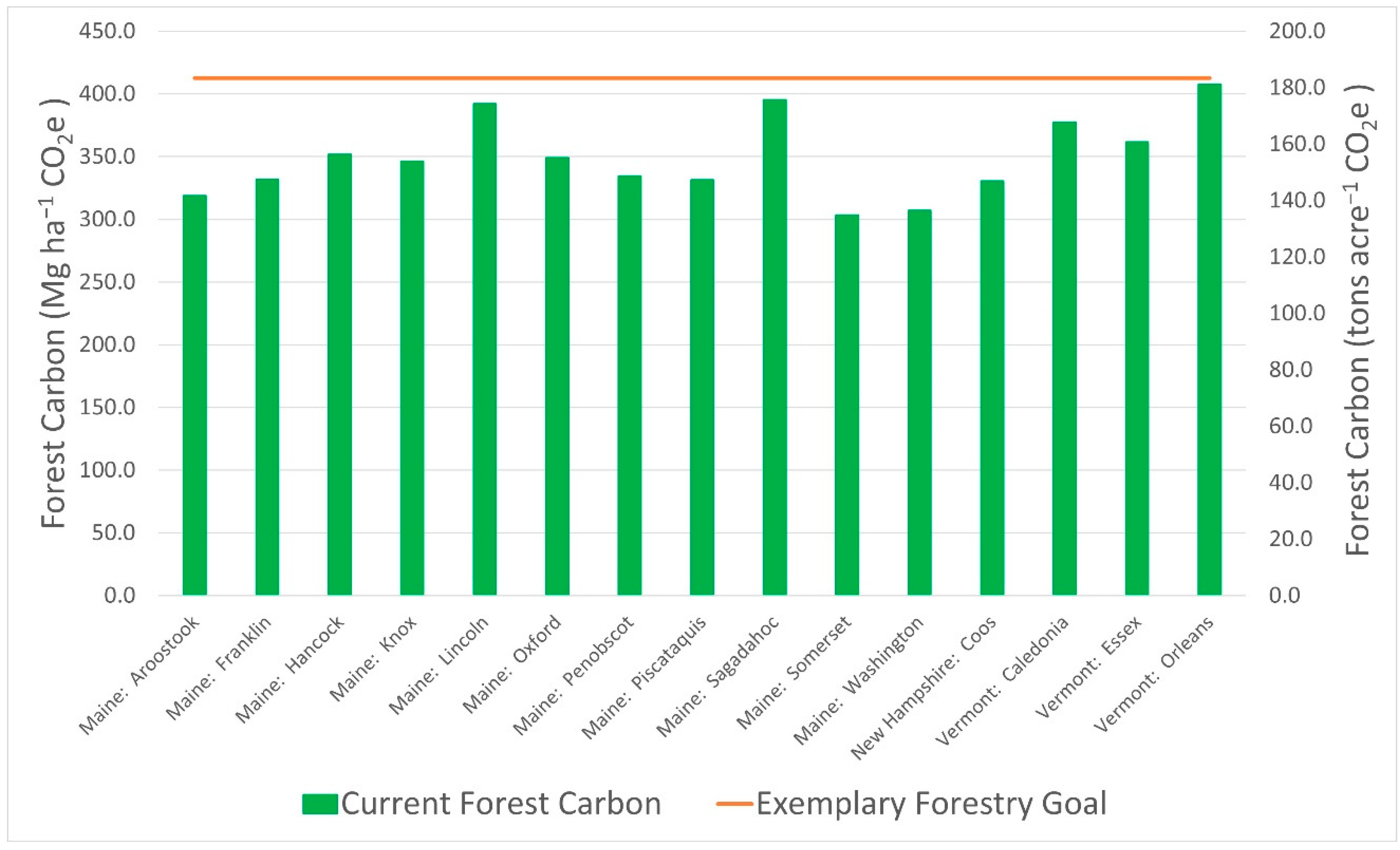Storing More Carbon by Improving Forest Management in the Acadian Forest of New England, USA
Abstract
:1. Introduction

1.1. The Acadian Forest
1.2. Current Conditions in the Acadian Forest
1.3. Exemplary Forestry Standards
1.4. Study Goals
2. Materials and Methods
2.1. Growth and Yield Modeling
2.2. Estimating Carbon Impacts of EF
2.3. Financial Modeling
3. Results
3.1. Carbon Storage in the Forest
3.2. Financial Modeling
4. Discussion
4.1. Regional GHG Emissions Context
4.2. Temporal Context
“Climate scientists have quietly begun to converge on a stark conclusion: the window in which cutting emissions by reducing the use of fossil fuels alone can reverse climate change has essentially closed. To keep temperatures on the planet from rising 2 °C above preindustrial levels, the stated goal of the 2016 Paris Agreement, humanity will also have to swiftly develop ways to remove carbon from the atmosphere.”[62]
4.3. Economic Context
4.4. Forest Management and Ecological Implications
4.5. Conclusions
Supplementary Materials
Author Contributions
Funding
Data Availability Statement
Acknowledgments
Conflicts of Interest
Appendix A
| State | County | Mg ha−1 CO2e on Private Timberland, Excluding Soil Carbon | Carbon Gap, Mg ha−1 CO2e | Privately Owned Forestland in the Acadian Forest Region, ha | Total Opportunity, Million Mg CO2e |
|---|---|---|---|---|---|
| Maine | Aroostook | 318 | 94.9 | 1,453,944 | 138.0 |
| Franklin | 331 | 82.0 | 326,819 | 26.8 | |
| Hancock | 351 | 62.1 | 288,263 | 17.9 | |
| Knox | 345 | 67.5 | 31,554 | 2.1 | |
| Lincoln | 391 | 21.8 | 19,086 | 0.4 | |
| Oxford | 348 | 64.8 | 219,749 | 14.2 | |
| Penobscot | 333 | 79.2 | 597,994 | 47.4 | |
| Piscataquis | 330 | 82.3 | 833,034 | 68.6 | |
| Sagadahoc | 394 | 18.5 | 18,136 | 0.3 | |
| Somerset | 302 | 110.3 | 734,675 | 81.0 | |
| Washington | 306 | 106.5 | 561,807 | 59.9 | |
| New Hampshire | Coos | 329 | 83.2 | 277,381 | 23.1 |
| Vermont | Caledonia | 376 | 36.5 | 88,192 | 3.2 |
| Essex | 360 | 52.3 | 80,647 | 4.2 | |
| Orleans | 406 | 6.5 | 127,977 | 0.8 | |
| Total | 488.0 |
References
- Pan, Y.; Birdsey, R.A.; Fang, J.; Houghton, R.; Kauppi, P.E.; Kurz, W.A.; Phillips, O.L.; Shvidenko, A.; Lewis, S.L.; Canadell, J.G.; et al. A Large and Persistent Carbon Sink in the World’s Forests. Science 2011, 333, 988–993. [Google Scholar] [CrossRef] [Green Version]
- Olsson, L.; Barbosa, H.; Bhadwal, S.; Cowie, A.; Delusca, K.; Flores-Renteria, D.; Hermans, K.; Jobbagy, E.; Kurz, W.; Li, D.; et al. Land degradation. In Climate Change and Land: An IPCC Special Report on Climate Change, Desertification, Land Degradation, Sustainable Land Management, Food Security, and Greenhouse Gas Fluxes in Terrestrial Ecosystems; 2019; Available online: https://www.ipcc.ch/site/assets/uploads/2019/11/SRCCL-Full-Report-Compiled-191128.pdf (accessed on 6 July 2022).
- Oliver, C.D.; Nassar, N.; Lippke, B.R.; McCarter, J.B. Carbon, Fossil Fuel, and Biodiversity Mitigation with Wood and Forests. J. Sustain. For. 2014, 33, 248–275. [Google Scholar] [CrossRef] [Green Version]
- Erb, K.-H.; Kastner, T.; Plutzar, C.; Bais, A.L.S.; Carvalhais, N.; Fetzel, T.; Gingrich, S.; Haberl, H.; Lauk, C.; Niedertscheider, M.; et al. Unexpectedly large impact of forest management and grazing on global vegetation biomass. Nature 2017, 553, 73–76. [Google Scholar] [CrossRef] [PubMed]
- Griscom, B.W.; Adams, J.; Ellis, P.W.; Houghton, R.A.; Lomax, G.; Miteva, D.A.; Schlesinger, W.H.; Shoch, D.; Siikamäki, J.V.; Smith, P.; et al. Natural climate solutions. Proc. Natl. Acad. Sci. USA 2017, 114, 11645–11650. [Google Scholar] [CrossRef] [PubMed] [Green Version]
- Achim, A.; Moreau, G.; Coops, N.C.; Axelson, J.N.; Barrette, J.; Bédard, S.; Byrne, K.E.; Caspersen, J.; Dick, A.R.; D’Orangeville, L.; et al. The changing culture of silviculture. For. Int. J. For. Res. 2021, 95, 143–152. [Google Scholar] [CrossRef]
- Ameray, A.; Bergeron, Y.; Valeria, O.; Montoro Girona, M.; Cavar, X. Forest carbon management: A review of silvi-cultural practices and management strategies across boreal, temperate and tropical forests. Curr. For. Rep. 2021, 7, 245–266. [Google Scholar] [CrossRef]
- Kauppi, P.E.; Stål, G.; Arnesson-Ceder, L.; Sramek, I.H.; Hoen, H.F.; Svensson, A.; Wernick, I.K.; Högberg, P.; Lundmark, T.; Nordin, A. Managing existing forests can mitigate climate change. For. Ecol. Manag. 2022, 513, 120186. [Google Scholar] [CrossRef]
- Daigneault, A.; Simons-Legaard, E.; Birthisel, S.; Carroll, J.; Fernandez, I.; Weiskittel, A. Maine Forestry and Agriculture Natural Climate Solutions Mitigation Potential Final Report; The University of Maine: Orono, ME, USA, 2021. [Google Scholar] [CrossRef]
- Hennigar, C.R.; MacLean, D.A.; Amos-Binks, L.J. A novel approach to optimize management strategies for carbon stored in both forests and wood products. For. Ecol. Manag. 2008, 256, 786–797. [Google Scholar] [CrossRef]
- Cameron, R.E.; Hennigar, C.R.; MacLean, D.A.; Adams, G.W.; Erdle, T.A. A Comprehensive Greenhouse Gas Balance for a Forest Company Operating in Northeast North America. J. For. 2013, 111, 194–205. [Google Scholar] [CrossRef]
- Hof, A.R.; Girona, M.M.; Fortin, M.-J.; Tremblay, J.A. Editorial: Using Landscape Simulation Models to Help Balance Conflicting Goals in Changing Forests. Front. Ecol. Evol. 2021, 9, 795736. [Google Scholar] [CrossRef]
- Millar, C.I.; Stephenson, N.L.; Stephens, S.L. Climate change and the forests of the future: Managing in the face of uncertainty. Ecol. Appl. 2007, 17, 2145–2151. [Google Scholar] [CrossRef] [PubMed]
- Rotenberg, E.; Yakir, D. Contribution of Semi-Arid Forests to the Climate System. Science 2010, 327, 451–454. [Google Scholar] [CrossRef] [PubMed]
- Kurtén, T.; Kulmala, M.; Maso, M.D.; Suni, T.; Reissell, A.; Vehkamaki, H.; Hari, P.; Laaksonen, A.; Viisanen, Y.; Vesala, T. Estimation of different forest-related contributions to the radiative balance using observations in southern Finland. Boreal Environ. Res. 2003, 8, 275–286. [Google Scholar]
- Cherubini, F.; Bright, R.M.; Strømman, A.H. Site-specific global warming potentials of biogenic CO2 for bioenergy: Contributions from carbon fluxes and albedo dynamics. Environ. Res. Lett. 2012, 7, 045902. [Google Scholar] [CrossRef]
- Williams, C.A.; Gu, H.; Jiao, T. Climate impacts of U.S. forest loss span net warming to net cooling. Sci. Adv. 2021, 7, aax8859. [Google Scholar] [CrossRef]
- Covey, K.; Soper, F.; Pangala, S.; Bernardino, A.; Pagliaro, Z.; Basso, L.; Cassol, H.; Fearnside, P.; Navarrete, D.; Novoa, S.; et al. Carbon and Beyond: The Biogeochemistry of Climate in a Rapidly Changing Amazon. Front. For. Glob. Chang. 2021, 4, 618401. Available online: https://www.frontiersin.org/articles/10.3389/ffgc.2021.618401/full (accessed on 5 June 2022). [CrossRef]
- Lawrence, D.; Coe, M.; Walker, W.; Verchot, L.; Vandecar, K. The Unseen Effects of Deforestation: Biophysical Effects on Climate. Front. For. Glob. Chang. 2022, 5, 756115. [Google Scholar] [CrossRef]
- Foster, D.R. Land-Use History (1730–1990) and Vegetation Dynamics in Central New England, USA. J. Ecol. 1992, 80, 753. [Google Scholar] [CrossRef]
- Fargione, J.E.; Bassett, S.; Boucher, T.; Bridgham, S.D.; Conant, R.T.; Cook-Patton, S.C.; Ellis, P.W.; Falcucci, A.; Fourqurean, J.W.; Gopalakrishna, T.; et al. Natural climate solutions for the United States. Sci. Adv. 2018, 4, eaat1869. [Google Scholar] [CrossRef] [Green Version]
- Cook-Patton, S.C.; Leavitt, S.M.; Gibbs, D.; Harris, N.L.; Lister, K.; Anderson-Teixeira, K.J.; Briggs, R.D.; Chazdon, R.L.; Crowther, T.W.; Ellis, P.W.; et al. Mapping carbon accumulation potential from global natural forest regrowth. Nature 2020, 585, 545–550. [Google Scholar] [CrossRef]
- Seymour, R.S.; Hunter, M.L., Jr. New forestry in eastern spruce-fir forests: Principles and applications to Maine. MAES Misc. Publ. 1992, 716, 42. [Google Scholar]
- Westveld, M. Natural forest vegetation zones of New England. J. For. 1956, 54, 332–338. [Google Scholar] [CrossRef]
- Smith, D.C. A History of Lumbering in Maine, 1861–1960. Vol. 93. University of Maine Studies; University of Maine Press: Orono, ME, USA, 1972. [Google Scholar]
- Cowan, M.; Timberrr, M. A History of Logging in New England; Milbrook Press Inc.: Brookfield, CT, USA, 2003. [Google Scholar]
- Maine Forest Service. Wood Processor Reports, 2010–2019; Department of Agriculture, Conservation and Forestry, Maine Forest Service: Augusta, ME, USA, 2021. [Google Scholar]
- USDA Forest Service. Forest Inventory and Analysis Database; Department of Agriculture, Forest Service, Northern Research Station: St. Paul, MN, USA, 2022. Available online: https://apps.fs.usda.gov/fia/datamart/CSV/datamart_csv.html (accessed on 6 July 2022).
- Belair, E.P.; Ducey, M.J. Patterns in Forest Harvesting in New England and New York: Using FIA Data to Evaluate Silvicultural Outcomes. J. For. 2018, 116, 273–282. [Google Scholar] [CrossRef]
- Brown, M.L.; Canham, C.D.; Murphy, L.; Donovan, T.M. Timber harvest as the predominant disturbance regime in northeastern U.S. forests: Effects of harvest intensification. Ecosphere 2018, 9, ecs2.2062. [Google Scholar] [CrossRef]
- Buchholz, T.; Canham, C.D.; Hamburg, S.P.; Fund, E.D. Forest Biomass and Bioenergy: Opportunities and Constraints in the Northeastern United States; Cary Institute of Ecosystem Studies: Millbrook, NY, USA, 2011; Available online: https://forestindustries.eu/sites/default/files/userfiles/1file/report_biomass_2011.pdf (accessed on 16 October 2022).
- Buras, A.; Menzel, A. Projecting Tree Species Composition Changes of European Forests for 2061–2090 Under RCP 4.5 and RCP 8.5 Scenarios. Front. Plant Sci. 2019, 9, 1986. [Google Scholar] [CrossRef] [PubMed] [Green Version]
- Feeley, K.J.; Bravo-Avila, C.; Fadrique, B.; Perez, T.M.; Zuleta, D. Climate-driven changes in the composition of New World plant communities. Nat. Clim. Chang. 2020, 10, 965–970. [Google Scholar] [CrossRef]
- Bose, A.K.; Weiskittel, A.; Wagner, R.G. Occurrence, pattern of change, and factors associated with American beech-dominance in stands of the northeastern USA forest. For. Ecol. Manag. 2017, 392, 202–212. [Google Scholar] [CrossRef] [Green Version]
- Gunn, J.S.; Ducey, M.J.; Belair, E. Evaluating degradation in a North American temperate forest. For. Ecol. Manag. 2018, 432, 415–426. [Google Scholar] [CrossRef]
- Pounch, M.A.; Fenner, C.A.; Giffen, R.A. Landscape Scale Habitat Needs in the Mountains of the Dawn; New England Forestry Foundation: Littleton, MA, USA, 2019. [Google Scholar]
- DeGraaf, R.M.; Yamasaki, M.; Leak, W.B.; Lester, A.M. Landowner’s Guide to Wildlife Habitat: Forest Management for the New England Region; University of Vermont Press: Burlington, VT, USA, 2005. [Google Scholar]
- Giffen, R.; Perschel, R. Exemplary Forestry for the 21st Century: Managing for Board Feet and Birds Feet in the Acadian Forest; New England Forestry Foundation: Littleton, NH, USA, 2019; 29p, Available online: https://newenglandforestry.org/wp-content/uploads/2019/07/Exemplary-Forestry-Acadian-Forest-040919-final.pdf (accessed on 6 June 2022).
- Leskinen, P.; Cardellini, G.; Gonzalez-Garcia, S.; Hurmekoski, E.; Sathre, R.; Seppala, J.; Smyth, C.; Stern, T.; Verkerk, P.J. Substitution Effects of Wood-Based Products in Climate Change Mitigation; From Science to Policy 7; European Forest Institute: Joensuu, Finland, 2018. [Google Scholar]
- Ganguly, I.; Pierobon, F.; Hall, E.S. Global Warming Mitigating Role of Wood Products from Washington State’s Private Forests. Forests 2020, 11, 194. [Google Scholar] [CrossRef] [Green Version]
- Gunn, J.; Buchholz, T. Forest sector greenhouse gas emissions sensitivity to changes in forest management in Maine (USA). For. Int. J. For. Res. 2018, 91, 526–538. [Google Scholar] [CrossRef]
- Sathre, R.; O’Connor, J. Meta-analysis of greenhouse gas displacement factors of wood product substitution. Environ. Sci. Policy 2010, 13, 104–114. [Google Scholar] [CrossRef]
- Puhlick, J.J.; Weiskittel, A.R.; Kenefic, L.; Woodall, C.W.; Fernandez, I.J. Strategies for enhancing long-term carbon sequestration in mixed-species, naturally regenerated Northern temperate forests. Carbon Manag. 2020, 11, 381–397. [Google Scholar] [CrossRef]
- Simons, E.; Harrison, D.; Whitman, A.; Wilson, J. Quantifying Biodiversity Values Across Managed Landscapes in Northern and Western Maine. Final Report to the Cooperative Forestry Research Unit; University of Maine Cooperative Forestry Research Unit: Orono, ME, USA, 2010; Available online: https://www.researchgate.net/publication/275641048_Quantifying_Biodiversity_Values_across_Managed_Landscapes_In_Northern_And_Western_Maine?channel=doi&linkId=554107a30cf2b790436bc473&showFulltext=true (accessed on 6 June 2022).
- Leak, W.B.; Yamasaki, M.; Holleran, R. Silvicultural Guide for Northern Hardwoods in the Northeast; Northern Research Station, Gen. Tech. Rep. NRS-132; USDA Forest Service: Newtown Square, PA, USA, 2014; Available online: https://www.fs.fed.us/nrs/pubs/gtr/gtr_nrs132.pdf (accessed on 6 June 2022).
- Frank, R.M.; Bjorkbom, J.C. A Silvicultural Guide for Spruce-Fir in the Northeast; Northeastern Forest Experiment Station, USDA Forest Service: Upper Darby, PA, USA, 1973. [Google Scholar] [CrossRef]
- Crookston, N.L.; Dixon, G.E. The forest vegetation simulator: A review of its structure, content, and applications. Comput. Electron. Agric. 2005, 49, 60–80. [Google Scholar] [CrossRef]
- Irland, L.C.; Hagan, J.; Lutz, J. Large Timberland Transactions in the Northern Forest 1980–2006: Analyzing an Historic Landownership Change, GISF Research Paper 011; Yale University School of Forestry and Environmental Studies: New Haven, CT, USA, 2010. [Google Scholar]
- Jin, S.; Sader, S.A. Effects of forest ownership and change on forest harvest rates, types and trends in northern Maine. For. Ecol. Manag. 2006, 228, 177–186. [Google Scholar] [CrossRef]
- Sass, E.M.; Markowski-Lindsay, M.; Butler, B.J.; Caputo, J.; Hartsell, A.; Huff, E.; Robillard, A. Dynamics of Large Corporate Forestland Ownerships in the United States. J. For. 2021, 119, 363–375. [Google Scholar] [CrossRef]
- California Air Resources Board. Compliance Offset Protocol US Forest Projects. California Environmental Protection Agency. 2015. Available online: https://ww2.arb.ca.gov/our-work/programs/compliance-offset-program/compliance-offset-protocols/us-forest-projects/2015 (accessed on 15 October 2022).
- Johnson, D.W.; Curtis, P.S. Effects of forest management on soil C and N storage: Meta analysis. For. Ecol. Manag. 2001, 140, 227–238. [Google Scholar] [CrossRef]
- James, J.; Page-Dumroese, D.; Busse, M.; Palik, B.; Zhang, J.; Eaton, B.; Slesak, R.; Tirocke, J.; Kwon, H. Effects of forest harvesting and biomass removal on soil carbon and nitrogen: Two complementary meta-analyses. For. Ecol. Manag. 2021, 485, 118935. [Google Scholar] [CrossRef]
- Kaarakka, L.; Cornett, M.; Domke, G.; Ontl, T.; Dee, L.E. Improved forest management as a natural climate solution: A review. Ecol. Solutions Évid. 2021, 2, 12090. [Google Scholar] [CrossRef]
- Orrego, J. Written Statement of the American Forest Carbon Registry at Winrock International to the Senate Committee on Agriculture, Forestry, and Nutrition. 2021. Available online: https://www.agriculture.senate.gov/hearings/federal-state-and-private-forestlands-opportunities-for-addressing-climate-change (accessed on 16 October 2022).
- Greenhouse Gas Emissions from a Typical Passenger Vehicle, U.S. Environmental Protection Agency (EPA) Report, Office of Transportation and Air Quality. March 2018. Available online: https://nepis.epa.gov/Exe/ZyPDF.cgi?Dockey=P100U8YT.pdf (accessed on 6 July 2020).
- U.S. Energy Information Administration. State Carbon Dioxide Emissions Data—U.S. Energy Information Administration (EIA): State Energy-Related Carbon Dioxide Emissions by Year (Table 1). 2022. Available online: https://www.eia.gov/environment/emissions/state/index.php (accessed on 6 June 2022).
- Meyer, S.R.; Macleod, K.K.; Thompson, J.R.; Foster, D.R.; Perschel, R.; Knobloch, N.S.C.; Liebowitz, J.; Donahue, B.; Giffen, A.; Vaughn, T.; et al. New England’s Climate Imperative: Our Forests as a Natural Climate Solution; Highstead: Redding, CT, USA, 2022. [Google Scholar]
- Law, B.E.; Hudiburg, T.W.; Berner, L.T.; Kent, J.J.; Buotte, P.C.; Harmon, M.E. Land use strategies to mitigate climate change in carbon dense temperate forests. Proc. Natl. Acad. Sci. USA 2018, 115, 3663–3668. [Google Scholar] [CrossRef] [Green Version]
- Chen, S.; Lu, N.; Fu, B.; Wang, S.; Deng, L.; Wang, L. Current and future carbon stocks of natural forests in China. For. Ecol. Manag. 2022, 511, 120137. [Google Scholar] [CrossRef]
- IPCC. Climate Change 2022: In Mitigation of Climate Change. Contribution of Working Group III to the Sixth Assessment Report of the Intergovernmental Panel on Climate Change; Shukla, P.R., Skea, J., Slade, R., Al Khourdajie, A., van Diemen, R., McCollum, D., Pathak, M., Some, S., Vyas, P., Fradera, R., Eds.; Cambridge University Press: Cambridge, UK; New York, NY, USA, 2022. [Google Scholar] [CrossRef]
- Piore, A. Carbon-Sucking Bionic Weeds Are New Front in Climate War. Bloom. Businessweek. 2020. Available online: https://www.bloomberg.com/news/articles/2020-09-25/climate-change-biologists-develop-carbon-sucking-bionic-plants (accessed on 7 January 2022).
- Granstrom, M.; Crandall, M.S.; Kenefic, L.S.; Weiskittel, A.R. Tree quality and value: Results in northern conifer stands after 65 years of silviculture and harvest. Can. J. For. Res. 2022, 52, 794–807. [Google Scholar] [CrossRef]
- Kenefic, L.; Sendak, P.E.; Brissette, J.C. Comparison of Fixed Diameter-Limit and Selection Cutting in Northern Conifers. North. J. Appl. For. 2005, 22, 77–84. Available online: http://www.fs.usda.gov/treesearch/pubs/20688 (accessed on 19 June 2022). [CrossRef] [Green Version]
- FORMaine. Forest Opportunity Roadmap/Maine. 2018. Available online: https://formaine.org/wp-content/uploads/2020/09/FORMaine_Report_DL_041119.pdf (accessed on 6 June 2022).
- Šimpraga, M.; Ghimire, R.P.; Van Der Straeten, D.; Blande, J.D.; Kasurinen, A.; Sorvari, J.; Holopainen, T.; Adriaenssens, S.; Holopainen, J.K.; Kivimäenpää, M. Unravelling the functions of biogenic volatiles in boreal and temperate forest ecosystems. Forstwiss. Centralblatt 2019, 138, 763–787. [Google Scholar] [CrossRef] [Green Version]
- Duveiller, G.; Filipponi, F.; Ceglar, A.; Bojanowski, J.; Alkama, R.; Cescatti, A. Revealing the widespread potential of forests to increase low level cloud cover. Nat. Commun. 2021, 12, 1–15. [Google Scholar] [CrossRef]
- Cerasoli, S.; Yin, J.; Porporato, A. Cloud cooling effects of afforestation and reforestation at midlatitudes. Proc. Natl. Acad. Sci. USA 2021, 118, e2026241118. [Google Scholar] [CrossRef] [PubMed]






| Summary | ||
|---|---|---|
| Acquisition | ||
| Total hectares | 2000 | |
| Price per hectare | USD 2471 | |
| - Plus: transactions costs | USD 111 | |
| Total acquisition price per hectare | USD 2582 | |
| Capital stack | ||
| All in acquisition cost | USD 5,164,495 | |
| Total equity required (35%) | USD 1,806,701 | |
| Philanthropic easement (48%) | USD 2,471,050 | |
| Debt/loan (17%) | USD 886,744 | |
| Return to equity (real) | ||
| Investor hold period (years) | 15 | |
| - Whole dollar profit | USD 3,240,994 | |
| - Multiple on invested capital | 2.97 | |
| Holding period nominal IRR | 7.09% | |
| Holding period real IRR | 4.43% | |
| Revenues Over Holding Period | ||
| Carbon | ||
| Average carbon credits per hectare per year for holding period | 5.79 | |
| Price per credit in year 1 (USD/Mg CO2e)) | USD 6.00 | |
| Growth rate of carbon pricing (per year) | 3% | |
| Weighted average carbon price over 15 years (holding period) | USD 10.92 | |
| Total carbon revenue (per hectare) | USD 949 | |
| Total carbon revenue | USD 1,898,549 | |
| Timber | ||
| Total timber revenue (per hectare) | USD 202 | |
| Total timber revenue | USD 404,628 | |
| Conservation easement | ||
| Easement value (% of acquisition cost) | 50% | |
| Easement value (per hectare) | USD 1236 | |
| Total easement value | USD 2,471,050 | |
| Recreation | ||
| Recreation revenue (per hectare, year 1) (existing camp leases) | USD 0.72 | |
| Growth in recreation revenue (per year) | 2% | |
| Total recreation revenue (per hectare) | USD 12.45 | |
| Total recreation value | USD 24,907 | |
| Disposition | ||
| Post easement (encumbered) value (per hectare) | USD 6277 | |
| Additional discount for Exemplary Forestry easement | 10% | |
| Growth rate in value | 6% | |
| - Less: EFM discount (60%) | USD (3776) | |
| Encumbered value at disposition (per hectare) | USD 2511 | |
| Disposition value | USD 4,971,650 | |
| Expenses | ||
| Total expenses (per hectare) | USD (338) | |
| Total expenses value | USD (675,072) |
Publisher’s Note: MDPI stays neutral with regard to jurisdictional claims in published maps and institutional affiliations. |
© 2022 by the authors. Licensee MDPI, Basel, Switzerland. This article is an open access article distributed under the terms and conditions of the Creative Commons Attribution (CC BY) license (https://creativecommons.org/licenses/by/4.0/).
Share and Cite
Giffen, R.A.; Ryan, C.M.; Belair, E.P.; Pounch, M.A.; Brown, S. Storing More Carbon by Improving Forest Management in the Acadian Forest of New England, USA. Forests 2022, 13, 2031. https://doi.org/10.3390/f13122031
Giffen RA, Ryan CM, Belair EP, Pounch MA, Brown S. Storing More Carbon by Improving Forest Management in the Acadian Forest of New England, USA. Forests. 2022; 13(12):2031. https://doi.org/10.3390/f13122031
Chicago/Turabian StyleGiffen, Robert Alec, Colleen M. Ryan, Ethan P. Belair, Michael A. Pounch, and Seth Brown. 2022. "Storing More Carbon by Improving Forest Management in the Acadian Forest of New England, USA" Forests 13, no. 12: 2031. https://doi.org/10.3390/f13122031




